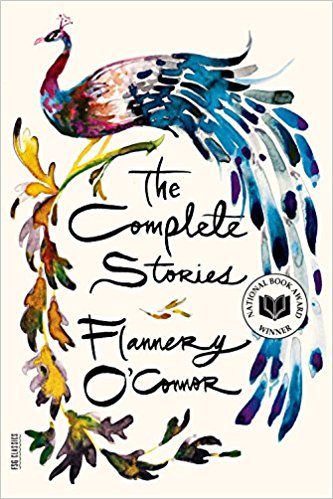The Complete Stories of Flannery O’Connor
–Review by Teri Hyrkas
“Why would Flannery O’Connor ruin her short stories by including gratuitous violence in them?” This was the question raised by a friend who heard that I had attended a week-long class at The Glen Workshop on O’Connor. It is a valid question, and one frequently asked about O’Connor’s work. It was also part of the reason I wanted to participate in the Glen’s offering called “Fun With Flannery.”
The class was taught by Dr. Karen Swallow Prior, Professor of English at Liberty University, and was a fascinating plunge into Flannery’s writing, with a special emphasis on her short stories. The primary book used for our topic was The Complete Stories of Flannery O’Connor (Farrar, Straus and Giroux, 1971) which contains thirty-one of Flannery’s short stories, nine of which were discussed in the workshop.
Mary Flannery O’Connor (1925-1964) is a distinctive author in a number of ways, but the characteristics that most readers identify with her fiction are her many grotesque characters and the use of violence in her stories. These aspects of her work are disturbing, but as Flannery said, “The truth does not change according to our ability to stomach it.”
Flannery is regarded to be a master of the short story. About that form Dr. Prior suggested we think of Flannery’s short stories as poetry wherein “nothing is extra and nothing is wasted.” With this perspective in mind, our group spent time considering story titles and characters’ names; we paid particular attention to geographical settings, the use of color and the presence of symbols. We also read long sections of Flannery’s fiction aloud, which meant we had an enhanced experience of moments in the stories that were very funny, episodes that were touching, and various scenarios which contained violence.
As we discussed the violent sections of Flannery’s works, Dr. Prior helped us to see that these passages were not examples of gratuitous violence, but were pivotal points in the plot; moments where grace could break through or a sudden understanding might come upon a character. According to Dr. Prior, O’Connor employed violent action as a technique to force her characters to shake off the blinders of skewed moral judgments and cliché-entrenched thinking.
One of the stories the class discussed at length was “Revelation.” The main character is Mrs. Ruby Turpin, a woman who believes that she is entitled to freely judge others’ character by virtue of her position in society as a good, white, Christian woman who has status because she and her husband own a pig farm. Their farming operation is clearly top-shelf, she says, because, “Our hogs are not dirty and they don’t stink.”
As Ruby and her husband, Claud, sit in the lobby of a doctor’s office, Mrs. Turpin quietly makes her assessment of all the other people waiting to see the doctor, then begins to share her opinions with another woman in the clinic who she believes is her equal: a stylish, well-dressed grey-haired lady. Mrs. Turpin’s disparaging comments are an intense irritation to Mary Grace, a homely college-aged girl in the waiting room. Flannery writes that Mary Grace was “scowling into a thick blue book….She appeared annoyed that anyone should speak while she tried to read. The poor girl’s face was blue with acne and Mrs. Turpin thought how pitiful it was to have a face like that at that age.”
After one particularly vexing comment, Mrs. Turpin is struck in the head with a book thrown by Mary Grace; the student then attempts to strangle Mrs. Turpin. During their struggle Mrs. Turpin speaks directly to the young woman:
“What you got to say to me?” she asked hoarsely, and held her breath, waiting, as for a revelation.
The girl raised her head. Her gaze locked with Mrs. Turpin’s.
“Go back to hell where you came from, you old wart hog,” she whispered.
The college student was soon restrained by the clinic staff and Mrs. Turpin was sent home to recuperate from her injury. Ruby tried to rest but couldn’t because the comment made by the young woman disturbed her deeply — this is the moment of grace in the story. Ruby’s certainty about her privileged position in the world and in God’s eyes is as bruised and battered as her forehead, yet she received it as a means of grace and tries to understand what has happened to her.
Ruby wrestles with many questions as she later goes to the hog pen to spray down the animals with a water hose. While there, Ruby sees a vision of a troop of people walking toward heaven. Leading the procession are “freaks and lunatics.” At the very end of the horde are people like her, and “she could see by their shocked and altered faces that even their virtues were being burned away. She lowered her hands and gripped the rail of the hog pen, her eyes small but fixed unblinkingly on what lay ahead. In a moment the vision faded, but she remained where she was, immobile.
“At length, she got down and turned off the faucet and made her slow way on the darkening path to the house. In the woods around her the invisible cricket choruses had struck back up, but what she heard were the voices of the souls climbing upward in the starry field and shouting hallelujah.”
During the workshop, the class viewed several films based on O’Connor’s stories. There was also a documentary called Uncommon Grace: The Life of Flannery O’Connor (2015), directed by Bridget Kurt, in which one contributor remarked that O’Connor was “continuing Jesus’ work by telling parables to the modern world.” After spending a week immersed in Flannery O’Connor’s life and art, I believe Flannery was indeed a parable teller of extraordinary skill and that her short stories retain their power to awaken, provoke, and challenge the reader.

